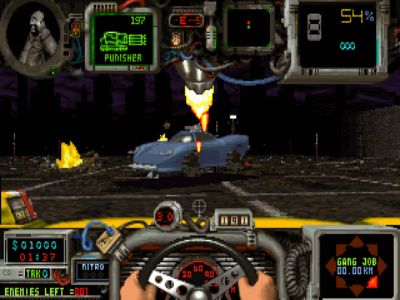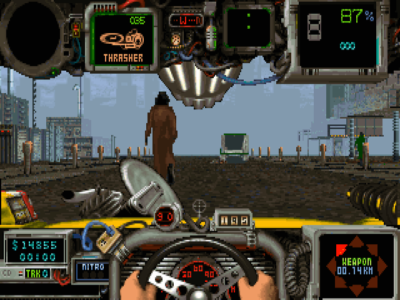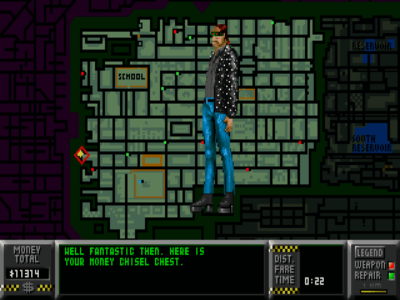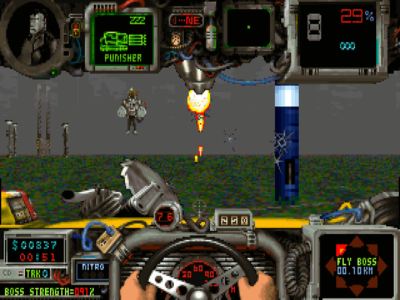
Quarantine
Written by: Rik
Date posted: October 21, 2012
- Genre: Action
- Developed by: Imagexcel
- Published by: Gametek
- Year released: 1994
- Our score: 5
In popular culture, taxis are often associated with people being in a hurry, which has never really been my experience in real life. Perhaps it’s because I make sure any planned taxi journeys always take place hours earlier than they really need to, in order to accommodate any combination of delays and disasters that may occur (but never do), and the only other time I need a cab is when I’ve had a beer or two and the only priority is to actually get home in one piece.
Things might be different, though, if I lived in Kemo City, the setting for the futuristic taxi-based knockabout otherwise known as Quarantine. In a setup that borrows liberally from films that have done this kind of thing before, particularly Escape from New York and Robocop, Kemo City is essentially what happens when the job of cleaning up a town with a high crime rate is passed to a private company with an evil name, whose solution involves constructing a massive perimeter wall and tampering with the water supply by introducing a chemical that’s designed to calm the population down but actually makes them go murderously bonkers instead. As Drake Edgewater, one of the few citizens of this lawless prison of psychotics not to be affected, your lot in life is to transport any other non-crazies around town in exchange for cash. Under such circumstances, you can kind of understand why people might be in a hurry, and/or reluctant to make their journey by foot.
To start with, the structure is quite simple: you are a taxi driver. You drive around Kemo until someone hails your cab; that person gets in and tells you where they want to go, how long you’ve got to get them there, and how much they’ll pay you; then you, well, drive them there. If you run out of time, the proposed fare then starts to count down instead. To complicate matters, Kemo is (as we mentioned) a fairly dangerous place to try and make a living, with gun-toting, red-eyed pedestrians lining up to take a pot-shot at your cab, and other road users veering all over the place in front of you, dropping the occasional mine in your path for good measure. As a result, much of your hard-earned cash must be re-invested in repairs and armour – as well as an array of weaponry should you wish to employ more assertive methods of survival.
It would be a bit of a stretch to call Quarantine a driving game. The futuristic setting means we’re in hover-cab territory here, and it certainly doesn’t handle much like a car. There’s even a ‘jump’ button, which is useful for avoiding mines and other hazards, but doesn’t make an awful lot of sense otherwise. Your taxi takes some getting used to at first, and the natural temptation to floor the accelerator will send you careering all over the place, into vehicles and other scenery, causing a significant amount of accidental damage. Impatient gamers may be tempted to give up at this stage, but with a little practice things do get easier.

This gang in the floating blue cars are going to be sorry they ever messed with Mr Drake Edgewater. Very sorry indeed.
Driving isn’t the only thing you’ll be doing in Quarantine. As you progress, the people hailing your cab will start to ask for things other than to drive them across town. You’re invited to participate in acts of terrorism aimed at the evil corporate overlords responsible for Kemo City, Omnicorp, either by bombing their buildings or attacking employees, or gangs financed by the company. Aside from the usual cash incentive, your involvement in anti-Omnicorp activities also provides other rewards, in the form of a passcode to escape to another area of the city and, ultimately, freedom.
So what we have here is a freeform action/driving hybrid, similar to Carmageddon, Grand Theft Auto (and even *shudder* Zone Raiders) but which predates all of them. Some might go so far as to say this game was an influence on its more successful and recent counterparts, but although I can see where such thoughts come from, it’s important not to overstate the lineage too much. In Quarantine, there’s not really an awful lot to do, and although you do have the freedom to drive around as you please, and even refuse fares and missions if you want, once you’ve spent a few minutes running over pedestrians and shooting other cars, there’s really little scope for exploration or other hi-jinks.
It is, though, moderately enjoyable. The bleakness of your surroundings comes across well, as does as the claustrophobia associated with being trapped in a hostile environment: you genuinely do feel as if you’re locked in a futuristic nut-house. The graphics are suitably apocalyptic, and the sounds mainly consist of explosions and screams of despair, which fit the setting quite well. Each fare or mission is usually over, whether you succeed or fail, in a couple of minutes, which works well in terms of persuading you to just keep playing for a bit longer to get the next mission, fare, or repair job done. On the second level, there was a boss battle I found particularly challenging, and when my repeated failure prompted furious re-loading of my saved game in an attempt to beat it, I didn’t quit until I was done (and when I was, I gave my new save a pathetically triumphal name along the lines of “I am the hardest fucker alive” – a sure sign of getting properly involved with a game).
Quarantine‘s main flaw is that it gets pretty repetitive after a while. People either stop you for a ride, a delivery, or a mission, and the missions are fairly samey (if they’re not combat-based, then they’re like any other fare or delivery). The combat, with the exception of the boss on the second level noted above, isn’t particularly challenging in terms of enemy AI, with your foes often floating about aimlessly until you put them out of their misery. Any difficulties encountered arise from a combination of a tight time limit and the problems inherent in trying to shoot and drive at the same time (however much Quarantine might resemble an FPS, there’s no strafe key).
There are other annoyances, too. The inhabitants of Kemo are, frankly, irritating. You’re constantly being fired at, or having mines thrown at you, or trying to dodge vehicles that get in your way. A bump with another car can send you spinning off some considerable distance, and they never seem inclined to try and avoid a collision – attempts to enter a weapons or repair bay are frequently interrupted by some moron shunting into you from the side. Getting stuck on the scenery, or in narrow alleyways, is a problem, too, particularly as you progress: indeed, the main hike in difficulty as you progress from level to level comes from increasing the number of ways the map can trip you up and the sheer amount of random damage-causing shit that gets thrown in your direction. The draw distance is quite poor, which reduces your chances of seeing hazards until it’s too late (and also increases those of running over a potential fare, as they stand haplessly in the middle of the road), and there are bugs – don’t try and access the map screen in the middle of a combat mission, for example, because it’ll mess everything up.
This was originally going to be a discussion review, but my colleague Stoo indicated that he just couldn’t stand to play it for long enough (“Sorry dude, I hate this game”). Such a reaction doesn’t come as a surprise – the most challenging parts are actually at the start, where money is sparse and you need fares just to be able to get your cab repaired once in a while. Once you get beyond those initial stages, the chances of hitting ‘game over’, or running out of money, decrease significantly. As it happens, I didn’t quite make it to the very end, not because I got horribly stuck, but because I just didn’t want to keep going. One of the main things that kept me interested was the possibility of uncovering some significant plot developments, but by the time I got to the final level, I realised they weren’t going to be forthcoming. Meanwhile, the methods used to make the game more challenging, as described above, were just getting on my nerves.
Overall, I had rather more fun than I thought I would, although there really isn’t all that much to it. Quarantine wins points for a decent idea, reasonably executed, but I’d take any claims from excitable retro-heads that this was the under-appreciated precursor to your modern open-world titles with a pinch of salt.
Note: I should mention that I played the bog-standard version of Quarantine: there is a CD version, which includes some video clips and some rockin’ tunes, apparently. I’m afraid I can’t comment on what they add (or don’t) to the game.





 Posts
Posts